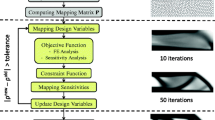Abstract
Critical issues of interactive three-dimensional geometry definition and high-speed parallel computation are addressed in a unified fashion by Geometry-Defining Processors (GDPs). GDPs are microprocessors housed in three-dimensional physical polyhedral packages which can be easily manually assembled or reconfigured to construct approximate scale models of physical objects or domains. An individual GDP communicates with neighboring GDPs in an assembly through optical ports associated with the faces of its package. An assembly of communicating GDPs is able to bothdefine a system geometry and, operating as an optimally connected parallel processor,solve the associated continuum partial differential equations required for design evaluation. Combining simplicity-of-use with efficient computational capabilities, the GDP design system should prove useful in numberous engineering applications.
Similar content being viewed by others
References
Anagnostou G, Fischer PF, Dewey D, Patera AT (1989) Finite/spectral element Navier-Stokes methods on vector hypercubes and geometry-defining processor reconfigurable lattices. In: Chao CC, Orszag S, Shyy W (eds) Proc US/ROC (Taiwan) Joint Workshop on Recent Advandaces in Comp Fluid Dynamics, pp 1–60
Athas WC, Seitz CL (1988) Multicomputers: message-passing concurrent computers. IEEE Comput 21:8:9–24
Bennett JA, Botkin ME (eds) (1986) The optimum shape. Plenum Press, New York
Blech RA (1987) The hypercluster: a parallel-processing testbed architecture for computational mechanics applications. NASA Tech Memo 89823, NASA Lewis Res Center, Cleveland, Ohio
Bokhari SH (1979) On the mapping problem. In: Proc 1979 Int Conf Parallel Processing, pp 239–248
Boyce JW, Gilchrist JE (1982) GMSolid: interactive modeling for design and analysis of solids. IEEE Comput Graph Appl 2:27–40
Dally WJ, Song P (1987) Design of a self-timed VLSI multi-computer communication controller. Proc IEEE Int Conf Comput Design: VLSI in Computers and Processors, pp 230–234
Dewey D, Patera AT (1988) Geometry-defining processors for partial differential equations. In: Alder BJ (ed) Special Purpose Computers. Academic Press, pp 67–96
Erlebacher G, Eiseman PR (1987) Adaptive triangular mesh generation. AIAA J 25 (10):1356–1364
Fay DQM, Das PK (1987) Hardware reconfiguration of transputer networks for distributed object-oriented programming. Microprocessing and Microprogramming 21:1965–1990
Fischer PF, Patera AT (1988) Parallel spectral element solution of the Stokes problem. J Comput Phys (to appear)
Fischer PF, Ho LW, Karniadakis GE, Rønquist EM, Patera AT (1988) Recent advances in parallel spectral element simulation of unsteady incompressible flows. Comput Struct 30:217–231
Fox G, Johnson M, Lyzenga G, Otto S, Salmon J, Walker D (1988) Solving problems on concurrent processors, vol 1. General techniques and regular problems. Prentice-Hall, Englewood Cliffs, New Jersey
Glowinski R, Golub GH, Meurant GA, Periaux J (eds) (1988) Proc First Int Conf on Domain Decomposition Methods for Partial Differential Equations. SIAM, Philadelphia
Gropp WD, Keyes DE (1988) Complexity of parallel implementation of domain decomposition techniques for elliptic partial differential equations. SIAM J Sci Stat Comput 9:312–326
Hoffman C, Hopcroft J (1985) Automatic surface generation in computer-aided design. The Visual Computer 1:92–100
Jain A (1986) Modern methods for automatic FE mesh generation. In: Baldwin K (ed) Proc Modern Methods for Automatic Finite Element Mesh Generation. ASCE National Convention, Boston, MA
Jordan HF (1978) A special purpose architecture for finite element analysis. In: Proc 1978 Int Conf on Parallel Processing, pp 263–266
Li H, Maresca M (1987) Polymorphic-torus network. In: Proc 1987 Int Conf on Parallel Processing, pp 411–414
Lin HX, Sips HJ (1986) A parallel vector reduction architecture. In: Proc 1986 Int Conf on Parallel Processing, pp 503–510
Maday Y, Patera AT (1989) Spectral element methods for the incompressible Navier-Stokes equations. In: Noor A, Oden JT (eds) State-of-the-Art Surveys in Computational Mechanics ASME, pp 71–143
May D (1987) The transpurer. In: Jesshope C (ed) Major Advances in Parallel Processing. Tech Press, Hampshire
McByron OA, Van de Velde EF (1987) Hypercube algorithms and implementations. In: Gear CW, Voigt RG (eds) Selected Papers from the Second Conference on Parallel Processing for Scientific Computing. SIAM, Philadelphia
Meagher DJ (1982) Geometric modelling using octree encoding. Comput Graph Image Proc 19:129–147
NEKTON User's Manual. Nektonics, 875 Main St, Cambridge, MA 02139
Patera AT (1984) A spectral element method for fluid dynamics: laminar flow in a channel expansion. J Comput Phys 54:468–488
Przemienecki JS (1979) Matrix structural analysis of substructures. AIAA J 1:239–248
Rayfield JT, Silverman HF (1988) System and application software for the Armstrong Multiprocessor. IEEE Computer 21(6):38–52
Requicha AAG, Voclcker HB (1982) Solid modeling: a historical summary and contemporary assessment. IEEE Comput Graph Appl, pp 9–24
Saad Y, Schultz MH (1985) Topological properties of hypercubes. Res Rep YALEU/DCS/RR-389, Yale Univ, New Haven
Scherr S (ed) (1988) Input Devices. Academic Press
Strang G, Fix GJ (1973) An Analysis of the Finite Element method. Prentice-Hall, Englewood Cliffs, New Jersey
Thompson JF (1988) Composite grid generation code for general 3-D regions — the EAGLE code. AIAA J 26(3):271–272
Yerry MA, Shephard MS (1984) Automatic three-dimensional mesh generation by the modified octree technique. Int J Numer Methods Eng 20:1965–1990
Zienkiewicz OC, Phillips DV (1971) An automatic mesh generation scheme for plane and curved surfaces by ‘isoparametric’ coordinates. Int J Numer Methods Eng 3:519–528
Author information
Authors and Affiliations
Rights and permissions
About this article
Cite this article
Anagnostou, G., Dewey, D. & Patera, A.T. Geometry-defining processors for engineering design and analysis. The Visual Computer 5, 304–315 (1989). https://doi.org/10.1007/BF01914788
Issue Date:
DOI: https://doi.org/10.1007/BF01914788




